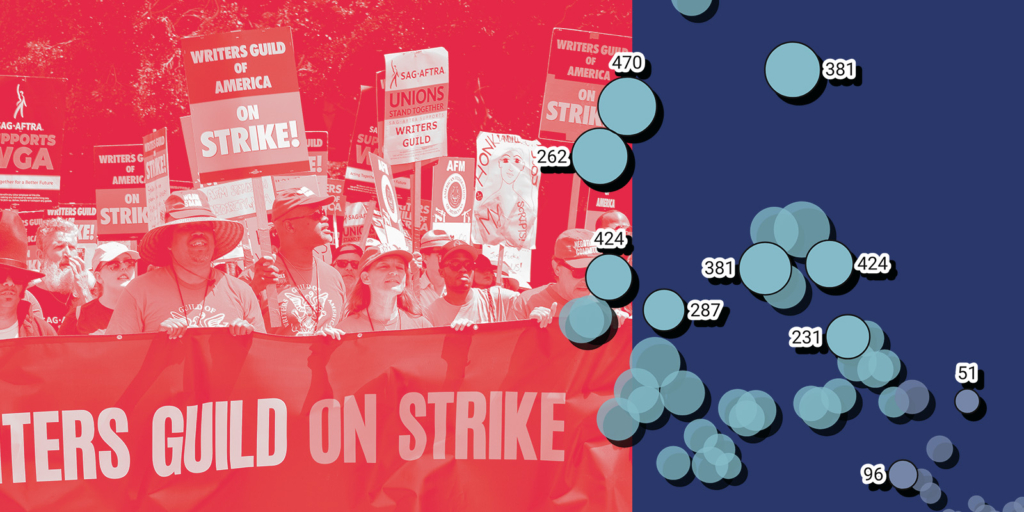This article is brought to you by Datawrapper, a data visualization tool for creating charts, maps, and tables. Learn more.
Hot Strike Summer: A Prequel
It’s Shaylee from the Customer Success and Support team, and this week I’ve been thinking about strikes.
Strikes are in the news this year: From the largest unions in Nigeria organizing general strikes for cost-of-living aid, to the Spanish women’s football league protesting unequal pay and treatment, workers and organizers have been making headlines all around the world. The U.S. in particular had a “Hot Strike Summer,” starting with the Writers Guild of America (which has since reached a landmark agreement with protections against AI) and including ongoing actions by screen actors, auto workers, and more. To put this summer in context, I wanted to take a look back at the past few decades of American labor history.
The Bureau of Labor Statistics has been gathering data on major work stoppages since the 1940s, and there are a few metrics they’ve kept continuously since then. Specifically relevant for us, they’ve measured details like the number of strikes reported, the number of workers involved in each strike, and total Days Not Worked (or DNW). I mapped this data out on a scatterplot, and immediately noticed a dramatic drop-off in all three metrics after 1981. What happened here?
I’m no labor historian, so this drop-off was a mystery to me at first, but it was remarkably clear in the data. The median number of strikes per year before 1981 was 270, which resulted in an average of 24,225,000 days not worked per year; compare that to a median of just 23 strikes per year after 1981, with an annual average of 4,377,000 DNW.
It wasn’t until I was talking through this statistical one-eighty with Rose that I found out there was a huge, historical reason for it: In 1981, the Professional Air Traffic Controllers Organization (PATCO) went on strike, protesting a contract in which the workers faced dangerously long work hours and low pay. The president at the time was Ronald Reagan, and after workers walked out he gave them an ultimatum: return to work in 48 hours, or be fired and banned from federal service for life. “End of statement.”
Reagan made good on this promise, and 11,345 strikers lost their jobs. The FAA hired replacements, but landing airplanes takes years of training; after the union was decertified and the strike broken, it took close to ten years to rebuild the federal air traffic control workforce to normal levels.
By setting a new standard for strikebreaking and changing the narrative on unions and coordinated labor action, the PATCO firings dealt a major blow to the U.S. labor movement. Employers held much more power; union membership fell dramatically, and the fear in workers’ minds was that companies would simply hire cheaper, less demanding replacements for any workers who dared to strike before coming to the negotiating table. (And many companies, of course, did do just that.)
In addition to this drastic action against unions and striking workers, the Reagan administration slashed the budget of the Bureau of Labor Statistics, which is responsible for recording data on strikes in the United States. Since 1981, the BLS has only recorded strikes involving more than 1,000 workers; to quote a 2022 report from the Cornell School of Industrial and Labor Relations, this shift in data collection “excludes the vast majority of strike activity and leaves practitioners, policymakers, and scholars misinformed about the true level of workplace conflict.”
Before that year, the BLS had required just six participating workers to record a strike, so the change created a huge gap in the data on smaller-scale actions. The International Labor Organization estimates that this policy change has hidden as many as 40% of days not worked from the official BLS tally. That's a lot of missing data — but the decrease in strike action is still very real. After attempting to account for unrecorded small strikes, the ILO estimates that since 1981:
- The total number of strikes has fallen from 4,378 to just 296 — a 93% decrease
- The number of workers involved in strikes has fallen from 2.1 million to 1.4 million — a 31% decrease
- The number of days not worked fell from 3.4 million to 2.4 million — a 29% decrease
It’s taken a long time for labor activists to build and rebuild organizing efforts since the ‘80s. But, as previously stated, strike activity has recently been picking up again — and it’s not going unrecorded.
In the course of learning about this piece of history, I came across many different organizations tracking, reporting, and visualizing the data around modern labor movements. I particularly wanted to spotlight the ILR School’s annual Labor Action Tracker, which has been reporting a considerable uptick of strikes since 2021.
Combine all that new effort (and new data!) with strong news coverage of today’s strikes and public approval of unions rising to levels not seen since the 1960s, and things start to look downright sunny for workers after this hot strike summer.
While this is definitely not all I have to say about labor organizing or Ronald Reagan, I’ll close the book on this chapter of history here. If you’ve got any leads on organizations fighting the good fight that I should keep up with, or other questions, comments, and perspectives, drop ‘em in the comments. Stay tuned for a Weekly Chart from Lisa next Thursday — oh, and before you go, check out my sources to read a lot more about strikes.
Sources and resources
- The homepage on work stoppages from the Bureau of Labor Statistics and a timeline of their data collection program.
- The 2021 and 2022 Labor Action Tracker reports from Cornell’s School of Industrial and Labor Relations.
- A 2002 report (PDF) from the International Labor Organization on their global work stoppages index.





Comments